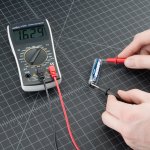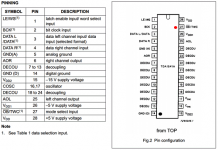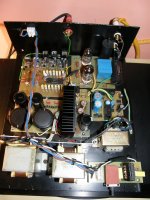Some buyers of vintage gear of the "collector type" are not even satisfied when they have 20 of them stacked upon eachother per type. Really, it is like a disease. I regularly meet such people. The "worst" are those that only own and literally do nothing with all the piled up stuff and nearly don't fit in their own houses themselves.
Shortest path from A to B is to have only 1 excellent machine. Cheaper too and one can only use 1 🙂
Shortest path from A to B is to have only 1 excellent machine. Cheaper too and one can only use 1 🙂
Pin 27 of TDA will be -5v if they are using Sim mode.Yes the sound is really good IMO. I have had several other dacs and presently compared the Orchid to my Soekris 2541 and iFI iDSD dacs.
I like all three and yes they are indeed different. Using a switchbox to compare etc...with several amps as well.
The Orchid seems to uncannily just draw you into the music...and I am an objective person...is it worth the $1300 retail...well ?
I cant find much out there on the Orchid as to the circuit design and operation or a schematic.
If anyone has any details other than the specs at mhdt.com please let us know.
Thanks
You know the story from this guy who has several yatchs ?
.... one plane is too much cheap ! And well, where he will park all his women !
.... one plane is too much cheap ! And well, where he will park all his women !
My answer to the topic title:
1. It is classic and I just love this PHI chip 🙂 Imagine how much music vent trough this model 🙂
2. It is true R2R topology (without R passive but active current networks)
3. It is classic Silicone BJ Transistor technology - not MOSFET
4. The sound is natural.
5. Better sounding in Time Simultaneous format
6. Current output DAC, open to accept different analog END stages.
....
I had before few decades, i think that was nineties, a OMG moment when I override som SAA PHI Digital filter, and disconnect compleat output stage replaced with some transistor IV in some Philips CD player. And TDA1541A was resposibile for this 🙂
.
Do not judge this dac via CD players implementations - Almost the same OP amp output design repeating for decades. And almost always with PHI oversampling filter ICs before TDA 🙁
It has to be "alone", with proper power supply, input digital data format and tube output stage IMHO.
.
(Maybe I like more TDA1540. Almost the same as written for the TDA1541A but for me more musical. With double bit rate 12MBit than TDA1541A 6MBit, TDA1540 without effort going to 384KHz. And it is fastest dac that producing the soun by dhanfging sample rate in the digital computer player. Almost instantly and without any click against ALL others chips...)
1. It is classic and I just love this PHI chip 🙂 Imagine how much music vent trough this model 🙂
2. It is true R2R topology (without R passive but active current networks)
3. It is classic Silicone BJ Transistor technology - not MOSFET
4. The sound is natural.
5. Better sounding in Time Simultaneous format
6. Current output DAC, open to accept different analog END stages.
....
I had before few decades, i think that was nineties, a OMG moment when I override som SAA PHI Digital filter, and disconnect compleat output stage replaced with some transistor IV in some Philips CD player. And TDA1541A was resposibile for this 🙂
.
Do not judge this dac via CD players implementations - Almost the same OP amp output design repeating for decades. And almost always with PHI oversampling filter ICs before TDA 🙁
It has to be "alone", with proper power supply, input digital data format and tube output stage IMHO.
.
(Maybe I like more TDA1540. Almost the same as written for the TDA1541A but for me more musical. With double bit rate 12MBit than TDA1541A 6MBit, TDA1540 without effort going to 384KHz. And it is fastest dac that producing the soun by dhanfging sample rate in the digital computer player. Almost instantly and without any click against ALL others chips...)
Interesting. I find if I like something I like it for good.It was a good DAC then.
What's not to like? Honest 13 bits. Or at least 12 and a half, but musical.Maybe I like more TDA1540
It is not wired it is classic. (Earlier oscilators was Tube circuits). But I dont know what is the catch about germanium anyway I tried some Ge buffer in the end of DAC and it changed the sound totaly, but on the maesurements was very the same. It was our member Kenatoken buffer, version with Ge parts.Full of weird topological choices with tube clock , germanium and tube stages and half wave rectifier PSU.
Abbas making the Time Simoultaneus format with some Altera or similar CPLD or some complex progamabile IC. That is off-course OK, but I find that use of the that other level of technology, is making the sound clearly rougher and maybe grainy? Giving tha sound signature into the whole device... 🙁 Maybe it is about the the tight and much smaller package of the elements inside, very high spead, too complex technology for nedded purposes? I dont know why, maybe I am wrong... 🙁
Last edited:
I dont know, just the sound, and measurements are pretty good. I find no other DAC that can convert 20KHz amazingly straight square wave. And it is mono, with little much space inside go the modules, probably that is the reason for high bit rate?What's not to like? Honest 13 bits. Or at least 12 and a half, but musical.
Except one has " infidelious" kind of mentality and likes blondes , brunettes, can't pass on green eyed red-haired ones and fat or thin they all bring something to the table . Pork , venicin, goat or beef , they all go as well with a small exception of modern " chikin" which doesn't have much in common with meat anyway 😀Some buyers of vintage gear of the "collector type" are not even satisfied when they have 20 of them stacked upon eachother per type. Really, it is like a disease. I regularly meet such people. The "worst" are those that only own and literally do nothing with all the piled up stuff and nearly don't fit in their own houses themselves.
Shortest path from A to B is to have only 1 excellent machine. Cheaper too and one can only use 1
I gave up and stopped pretending that it's all about music ..A day after I read first Hi-Fi mag some century ago I lost it an after a century of pretending I have to admit defeat and that I'm not a lesser idiot than everybody else involved in this silly " hobby" I had several CD players some of them quite expensive like Audio Research CD8 which I didn't like that much and which I absolutely couldn't afford . Sickness
Language error. I meant that it was so good that he spilled his coffee.Interesting. I find if I like something I like it for good.
What is good is good. Now the point is that many think there is better than good and even best. When the best is found the search for better than best begins. Then it is time to quit.
I remember nineties i found in the local store in Belgrade about 10 or more pieces... Nobody want them. At the town radio station TDA1541A was a spare part for the professional CD players. But with 2 x Crown. They abandon these CD players and double crowns sprae parts was not welcome any more... 🙁
Amazingly even today TDA1540 can obtain in stores time to time with price of about 15eu... But there are no TDA1541A any more. 🙁
Amazingly even today TDA1540 can obtain in stores time to time with price of about 15eu... But there are no TDA1541A any more. 🙁
Here is a pix of the guts for the latest Orchid. Its a TDA 1541A not and R that I first thought.

Just measured pin 26 to pin 14 GND and with the correct polarity is + 5.00 volts not - 5.00 volts.Pin 27 of TDA will be -5v if they are using Sim mode.
This means its operating in time MUX TWC ?
From the spec sheet:
When input OB/TWC input is connected to VDD1 the two channels of data (L/R) are input simultaneously via DATA L and DATA R, accompanied with BCK and a latch-enable input (LE). With this mode selected the data must be in offset binary. The converted samples appear at the output at the positive going transition of the latch enable signal.
Just measured pin 26 to pin 14 GND and with the correct polarity is + 5.00 volts not - 5.00 volts.Pin 27 of TDA will be -5v if they are using Sim mode.
This means its operating in time MUX TWC ?
.
it is not clear what You did at all?
first pin 27 in focus. Not pin 26 that is -V power pin (-5V)...
.
second connect correctly hand probes on voltmeter.
If it is TS format You should read -5V
(for other formats please read the datasheet)
.
Pin 27 is in between 26 (-5V power) and 28 (+5V power) for easy choice of that 2 settings...
Attachments
My bad....I meant to say measured pin 27 to ground.
Across 27 to 14.
27 is indeed +5VDC. not -5VDC.
And yes the polarity was correct. Black probe common to pin 14 ground...red lead + to pin 27.
So no simultaneous mode...so what does this really mean for "anything" ??
Alex
Across 27 to 14.
27 is indeed +5VDC. not -5VDC.
And yes the polarity was correct. Black probe common to pin 14 ground...red lead + to pin 27.
So no simultaneous mode...so what does this really mean for "anything" ??
Alex
Another reason for popularity is that it does not need any software programming, unlike more recent DAC chips. Just wire it up and it sounds. And its low clock rate means low jitter.
No need to measure the voltage of the Orchid as on the picture there are only three traces going to the tda inputs...so NO simultaneous. However what are those bunch of 3 ICs on the I2S lines?
Notice it uses a ceramic class 1 as dem clocking cap with what looks like 2 resistors arrengement from ECDESIGNS....bouhhhhh copycat ?
Notice it uses a ceramic class 1 as dem clocking cap with what looks like 2 resistors arrengement from ECDESIGNS....bouhhhhh copycat ?
Which device is the ceramic clocking cap?No need to measure the voltage of the Orchid as on the picture there are only three traces going to the tda inputs...so NO simultaneous. However what are those bunch of 3 ICs on the I2S lines?
Notice it uses a ceramic class 1 as dem clocking cap with what looks like 2 resistors arrengement from ECDESIGNS....bouhhhhh copycat ?
Interesting. Did you know that Mr Loesch designed the AMR CD77? Possibly one of the best TDA1541a machines out there. Are you also inferring that all of the reviews of it are biased in some way?Ha. I got pretty much the same response from a certain Mr Loesch many years ago when I was less than complimentary about the blessed TDA1541A, peace be upon it.
It seems as objectivists and subjectivists become more extreme they start to merge into the same thing. If you do not like our idol or our numbers then there is something wrong with you or your implementation.
- Home
- Source & Line
- Digital Source
- Why all the love for TDA1541?


